The first time I made Binagol at home, the sweet smell of steaming banana leaves instantly reminded me of childhood trips to Leyte. My grandmother would always bring this special treat back for us.
While the traditional recipe uses coconut shells, I've made it simpler with regular cake tins. The combination of taro and coconut cream creates that perfect chewy texture I remember, and I've made it less sweet to let the natural flavors stand out.
This vegan version has become my family's favorite weekend snack, keeping us connected to our Filipino roots even when we're far from home.
What is Binagol?
Binagol (bee-nah-gol) is a beloved Filipino delicacy originating from the Eastern Visayas Region, particularly Leyte province. This special kakanin (Filipino rice cake or sweet delicacy) is traditionally made from taro root (gabi) mixed with coconut cream and sugar, then steamed in coconut shells lined with banana leaves.
The name "Binagol" comes from the Waray word "bagol," meaning coconut shell. As a classic pasalubong (food souvenir) from Leyte, it's commonly found at Tacloban City Market and various transportation hubs where travelers purchase them as gifts for loved ones.
Jump to:
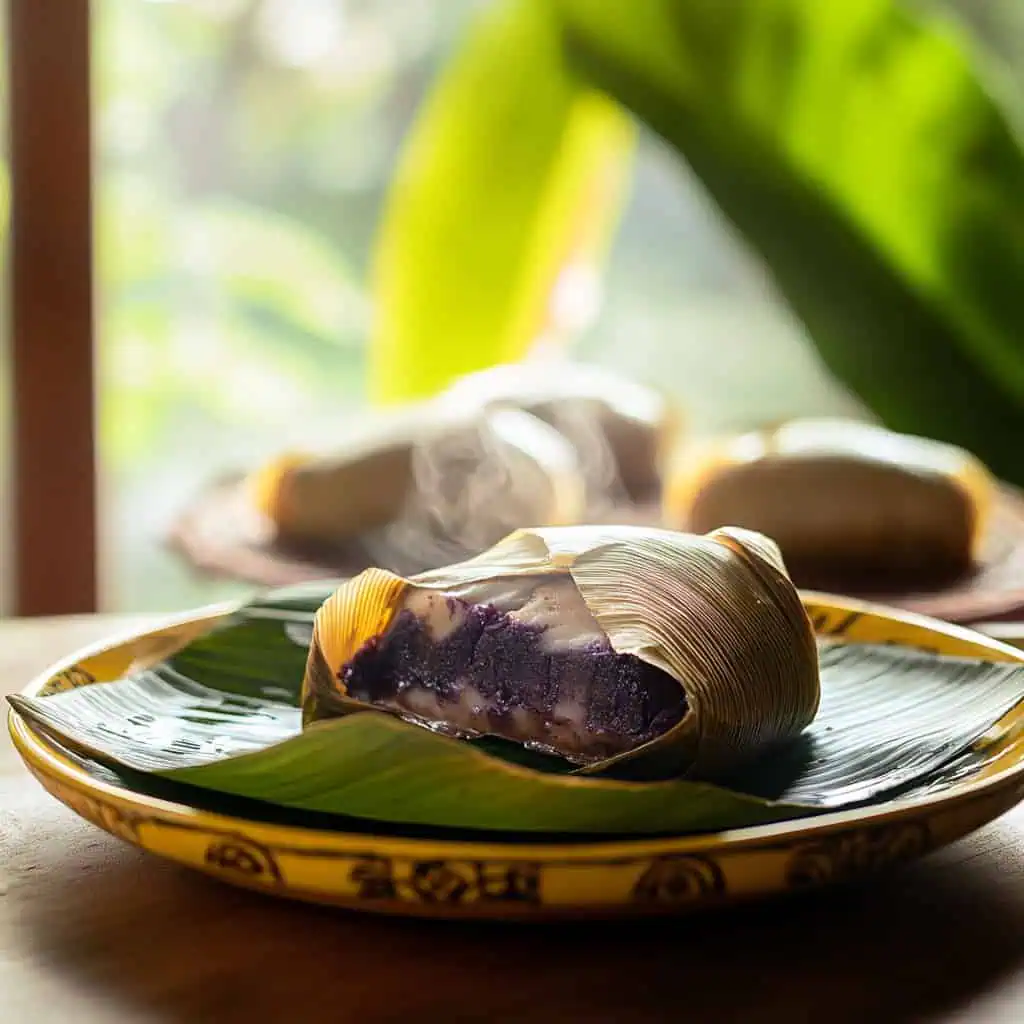
Why You'll Love This Recipe
- Perfect Balance of Flavors - The earthy taro combined with rich coconut cream creates a harmonious blend that's not too sweet
- Unique Texture - Achieves that signature chewy, pudding-like consistency that's incredibly satisfying
- Vegan-Friendly - This adaptation omits traditional condensed milk and egg yolks while maintaining authentic taste
- No Coconut Shells Needed - Uses readily available mini cake tins instead of hard-to-find coconut shells
- Impressive Presentation - Banana leaf wrapping creates an authentic, beautiful presentation
- Make-Ahead Friendly - Perfect for preparing a day before serving as it needs time to set properly
- Cultural Experience - Connect with Filipino culinary heritage through this traditional recipe
Ingredients
The taro root forms the heart of binagol, providing its signature earthy flavor and starchy texture that creates the perfect pudding-like consistency. Coconut cream adds rich creaminess and complements taro's natural nuttiness, while coconut sugar brings a caramel-like sweetness that's less sharp than refined sugar.
Banana leaves aren't just for presentation—they infuse the dessert with a subtle aromatic quality and help seal in moisture during steaming.
These ingredients have been used together for generations in Leyte because they create a perfect harmony between earthy, creamy, and sweet flavors while celebrating ingredients native to the Philippines.
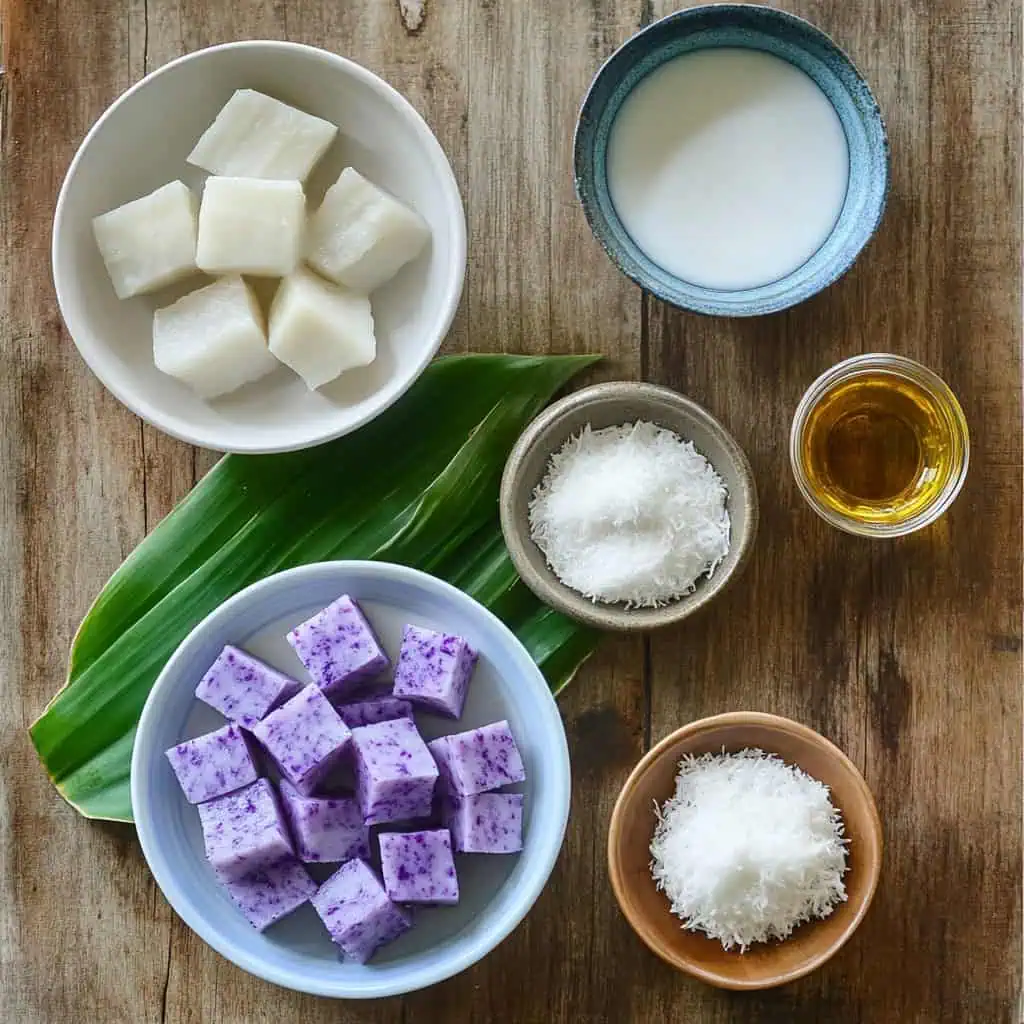
- 1 pound (450g) taro root (gabi), peeled and cubed
- 1 can (13.5 oz/400ml) coconut cream (not coconut milk)
- ½ cup (100g) coconut sugar (or Philippine muscovado sugar)
- 2 tablespoons coconut oil for brushing banana leaves
- 8-10 banana leaves cut into rounds or squares (for lining and wrapping)
Equipment
- Steamer - Essential for cooking both the taro root and the final binagol; ensures proper texture development and authentic cooking method
- Food processor - Creates the smooth, consistent texture needed for authentic binagol without any unwanted lumps
- 4-inch Round Cake Tins (2 inches deep) - Modern substitutes for traditional coconut shells, providing the perfect size and shape
- Banana Leaves - Essential wrapping that imparts authentic aroma and flavor while creating the traditional presentation
- Kitchen Towels - Used to wrap the steamer lid to prevent condensation from dripping onto the binagol during steaming
- String or Kitchen Twine - Secures the banana leaf wrapping to keep moisture and flavors sealed inside
- Measuring cups and spoons - Ensures accurate measurements for consistent results every time
- Knife and cutting board - Required for properly preparing the taro root, which needs precise cutting for even cooking
- Heat-resistant gloves - Protects hands when handling hot steamed items and prevents taro irritation
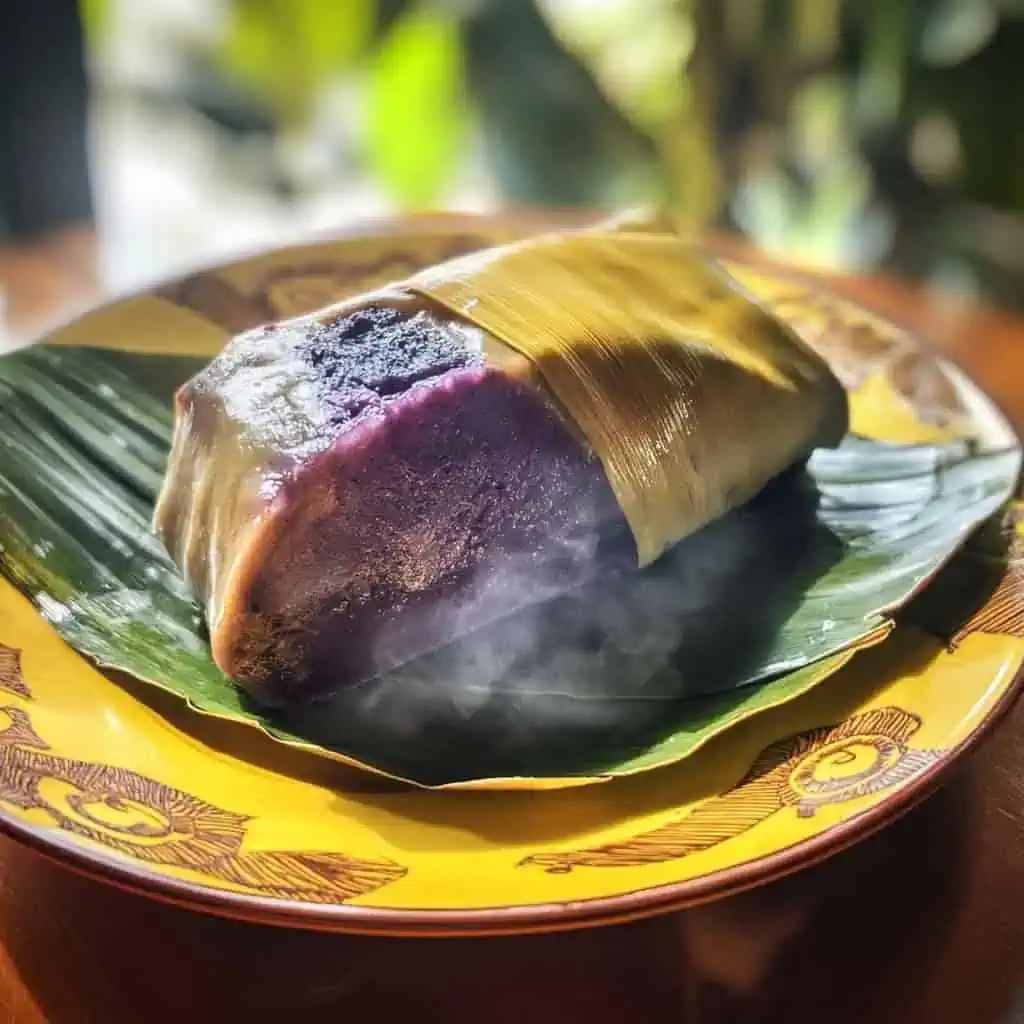
How To Make
- Prepare the taro: Wear gloves to peel the taro root to prevent skin irritation, then cut it into 1-inch cubes. Place the cubed taro in a steamer basket over boiling water (212°F/100°C). Steam for 20 minutes or until completely tender when pierced with a fork. Check water levels during steaming and add more hot water if needed.
- Make the mixture: Transfer the steamed taro to a food processor. Add the coconut cream and coconut sugar. Process until you achieve a smooth, thick consistency with no lumps. The mixture should be thick but pourable.
- Prepare banana leaves: Wash banana leaves thoroughly and pat dry. Cut into pieces that will fit your 4-inch cake tins with some overhang. Brush banana leaves with coconut oil and use them to line your cake tins, allowing the edges to hang over the sides.
- Fill the molds: Pour the binagol mixture into the lined cake tins, filling each about ¾ full. Place another banana leaf on top of each filled tin and fold the overhanging leaves over to seal. Secure with kitchen twine or ribbon.
- Steam the binagol: Place the wrapped tins in a steamer over boiling water (212°F/100°C). Wrap the steamer lid with a kitchen towel to prevent condensation from dripping onto the binagol. Steam for 20 minutes at medium-high heat.
- Cool and set: Remove from the steamer and allow to cool at room temperature for 2-3 hours. The binagol will appear slightly wet at first but will continue to set and firm up during this time. Serve directly from the banana leaf wrapping using a spoon.

Tips from Lola's Kitchen
- Taro Selection: Choose firm taro roots with minimal blemishes. When cut, fresh taro should be white with purple specks, not discolored. The freshest taro will give your binagol the best texture and flavor.
- Banana Leaf Preparation: Quickly pass banana leaves over an open flame or hot stovetop to make them more pliable and release their aroma. This brief heat treatment also sanitizes them and intensifies the natural oils that give binagol its distinctive fragrance.
- Perfect Consistency Test: The ideal binagol should be slightly firm but still creamy when scooped with a spoon—similar to a thick pudding. If you're unsure about doneness, check that a small amount holds its shape when placed on a plate.
- Taro Handling Safety: If your hands get itchy from handling raw taro, rub with vinegar to alleviate irritation. Always wear gloves when peeling and cutting raw taro to prevent skin reactions from the calcium oxalate crystals.
- Natural Flavor Enhancement: Let your binagol rest overnight in the refrigerator before serving to allow the flavors to fully develop and meld together. The texture will also firm up perfectly for that authentic mouthfeel.
- Serving Presentation: For special occasions, tie decorative ribbon around the finished binagol packets and add a small native spoon for an impressive gift presentation.
Substitutions
- No taro available? Purple sweet potato (ube) or regular sweet potato can substitute, though the flavor will be different. The texture will be less dense but still delicious.
- No coconut cream? Combine thick coconut milk with 2 tablespoons of coconut oil for a richer consistency that mimics the traditional mouthfeel.
- No coconut sugar? Use dark brown sugar or regular muscovado sugar. You can also use palm sugar (jaggery) for a similar caramel-like flavor profile.
- No banana leaves? Use parchment paper brushed with coconut oil (though you'll miss some of the traditional flavor). Food-grade lotus leaves can also work as an alternative wrapper.
- Dietary adjustments? For a lower-sugar version, reduce sugar to ¼ cup and add a teaspoon of vanilla extract to enhance perceived sweetness.
Troubleshooting
- Binagol is too soft: It may need more steaming time or hasn't set long enough. Allow to cool completely before refrigerating for at least 4 hours. You can also reduce coconut cream by 2 tablespoons in your next batch.
- Mixture is lumpy: Ensure taro is fully cooked and properly processed until smooth. If you don't have a food processor, press the cooked taro through a fine-mesh sieve before mixing with other ingredients.
- Banana leaves tearing: They may be too dry or old. Pass them briefly over heat to make them more pliable and use multiple overlapping layers if needed.
- Too sweet or not sweet enough: Adjust sugar to taste in your next batch. Traditional binagol from Leyte tends to be quite sweet, but personal preference varies widely.
- Binagol sticks to wrapping: Brush banana leaves more generously with coconut oil before filling. You can also line the leaves with a small piece of parchment paper at the bottom.
- Mixture seems too wet: Taro varieties can vary in moisture content. If your mixture seems too loose, add 1-2 tablespoons of cassava flour or rice flour to help it set properly.
Storage & Reheating
- Refrigeration: Binagol will keep in the refrigerator for up to 5 days when wrapped tightly in plastic wrap or stored in an airtight container. The flavor actually improves after the first day as the ingredients meld together.
- Freezing: Can be frozen for up to 3 months. Wrap individual portions in plastic wrap, then aluminum foil to prevent freezer burn. Label with the date to track freshness.
- Reheating: To enjoy warm, steam for 5-10 minutes until heated through. Microwaving is not recommended as it can create an uneven texture and may cause the binagol to become too soft.
- Room Temperature Serving: For the best texture and flavor, allow refrigerated binagol to come to room temperature (about 30 minutes) before serving. This enhances the creamy mouthfeel and aroma.
- Reviving Texture: If binagol becomes too firm after refrigeration, wrap in a banana leaf and steam for 3-5 minutes to restore its soft, pudding-like consistency.
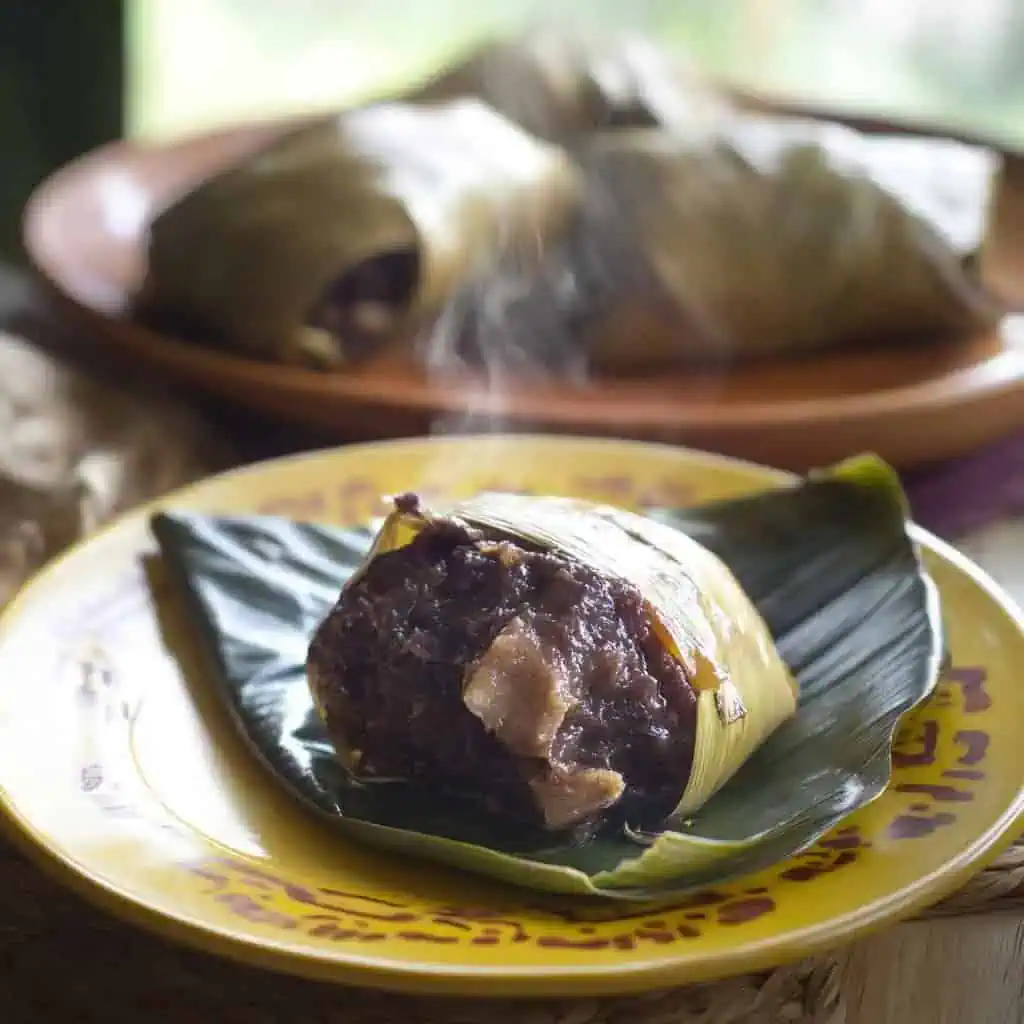
FAQ
What does binagol taste like?
Binagol has an earthy, nutty flavor from the taro, complemented by the rich creaminess of coconut and subtle caramel notes from the coconut sugar. The combination creates a unique taste that's not overwhelmingly sweet but deeply satisfying.
Is binagol vegan?
Traditional binagol often contains condensed milk and egg yolks, but this version is completely vegan while maintaining authentic flavor. The coconut cream provides all the richness needed without animal products.
Can I make binagol without banana leaves?
Yes, though banana leaves add a distinct aroma and flavor. Parchment paper can substitute but won't provide the same traditional flavor notes. If using parchment, add a drop of pandan extract to mimic some of the natural flavor.
How do I know when my binagol is done cooking?
After steaming for 20 minutes, the binagol may still appear slightly wet but will set further as it cools. It should have a slight jiggle in the center but not be liquid. The texture firms up considerably during the cooling process.
Why is my taro itchy to handle?
Raw taro contains calcium oxalate crystals that can cause skin irritation. Wear gloves when handling, and cooking neutralizes this effect. Never consume raw taro as these compounds can cause throat irritation.
How is binagol different from nilupak?
While both are mashed root vegetables with coconut, binagol is specifically taro with coconut cream and sugar, steamed in containers, while nilupak can be made with various root vegetables and is typically served fresh without the steaming process.
What makes binagol special among Filipino desserts?
Its unique preparation method, distinctive texture, and regional significance as a pasalubong from Leyte make it stand out among Filipino kakanin. The combination of steaming in banana leaves and the specific ratio of ingredients creates a flavor profile not found in other Filipino desserts.
Can I make mini binagol for parties?
Absolutely! Use small ramekins or silicone muffin cups lined with banana leaves to create bite-sized portions perfect for gatherings. Reduce steaming time to 15 minutes for these smaller versions.
Is binagol gluten-free?
Yes, traditional binagol is naturally gluten-free as it contains only taro, coconut products, and sugar. Just ensure any additional ingredients you might add don't contain gluten.
Can binagol be made in advance for special occasions?
Yes, binagol actually improves in flavor when made 1-2 days in advance. The flavors have time to meld and the texture sets perfectly, making it an ideal make-ahead dessert for celebrations.
Related
Looking for other recipes like this? Try these:
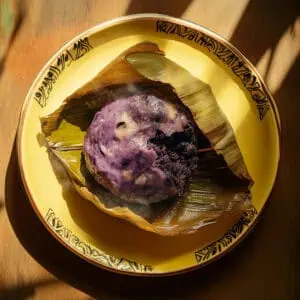
Authentic Binagol Recipe
Equipment
- Steamer Essential for cooking both the taro and the final binagol; a bamboo steamer works wonderfully but any steamer will do
- Food processor Creates the smooth, consistent texture needed for authentic binagol
- 4-inch Round Cake Tins (2 inches deep) Substitutes for traditional coconut shells
- Banana Leaves For lining and wrapping the binagol, providing authentic flavor and presentation
- Kitchen Towels Helpful for wrapping the steamer lid to prevent condensation dripping
- String or Kitchen Twine For securing the banana leaf wrapping
- Measuring cups and spoons For accurate ingredient measurements
- Knife and cutting board For peeling and cubing the taro
Ingredients
- 1 pound 450g taro root (gabi), peeled and cubed
- 1 can 13.5 oz/400ml coconut cream (not coconut milk)
- ½ cup 100g coconut sugar (or Philippine muscovado sugar)
- 2 tablespoons coconut oil for brushing banana leaves
- 8-10 banana leaves cut into rounds or squares (for lining and wrapping)
Instructions
- First, wear gloves to peel the taro root to prevent skin irritation, then cut it into 1-inch cubes (Balatan at hiwain ang gabi ng parisukat). Place the cubed taro in a steamer basket over boiling water (212°F/100°C). Steam for 20 minutes or until completely tender when pierced with a fork. Check water levels during steaming and add more hot water if needed (I-steam ang gabi sa loob ng 20 minuto o hanggang sa ito ay lumambot).
- Transfer the steamed taro to a food processor. Add the coconut cream and coconut sugar (Ihalo ang nilutong gabi, gata, at asukal sa food processor). Process until you achieve a smooth, thick consistency with no lumps. The mixture should be thick but pourable (I-blend hanggang maging malambot at walang butil-butil).
- Wash banana leaves thoroughly and pat dry. Cut into pieces that will fit your 4-inch cake tins with some overhang (Hugasan at patuyuin ang mga dahon ng saging. Gupitin ito ayon sa laki ng cake tin). Brush banana leaves with coconut oil and use them to line your cake tins, allowing the edges to hang over the sides (Pahiran ng langis ng niyog ang mga dahon ng saging at ilagay sa loob ng cake tin).
- Pour the binagol mixture into the lined cake tins, filling each about ¾ full (Ibuhos ang hinalong binagol sa cake tin na may dahon ng saging). Place another banana leaf on top of each filled tin and fold the overhanging leaves over to seal. Secure with kitchen twine or ribbon (Takpan ng isa pang dahon ng saging at talian ng mahigpit).
- Place the wrapped tins in a steamer over boiling water (212°F/100°C). Wrap the steamer lid with a kitchen towel to prevent condensation from dripping onto the binagol. Steam for 20 minutes at medium-high heat (I-steam ang binagol sa loob ng 20 minuto. Balutin ang takip ng steamer ng tuwalya para hindi tumulo ang tubig sa binagol).
- Remove from the steamer and allow to cool at room temperature for 2-3 hours. The binagol will appear slightly wet at first but will continue to set and firm up during this time (Palamigin sa temperatura ng kwarto sa loob ng 2-3 oras para tumigas nang maayos). Serve directly from the banana leaf wrapping using a spoon (Ihain na nakawrap pa rin sa dahon ng saging at kainin gamit ang kutsara).
Tips from Lola's Kitchen
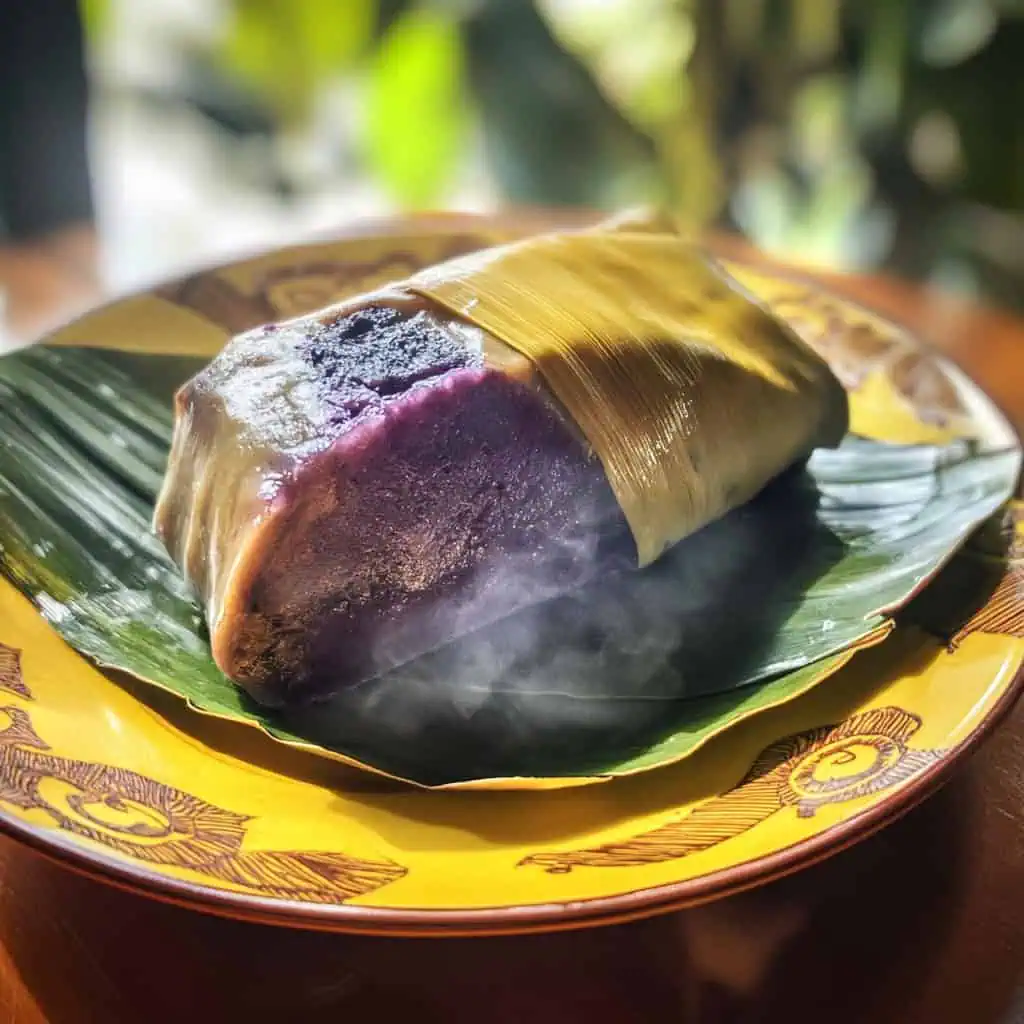
- Taro Selection: Choose firm taro roots with minimal blemishes. When cut, fresh taro should be white with purple specks, not discolored.
- Banana Leaf Preparation: Quickly pass banana leaves over an open flame or hot stovetop to make them more pliable and release their aroma.
- Perfect Consistency: The ideal binagol should be slightly firm but still creamy when scooped with a spoon—similar to a thick pudding.
- Taro Handling: If your hands get itchy from handling raw taro, rub with vinegar to alleviate irritation.
- Natural Molds: If you happen to have coconut shells, use them for the most authentic presentation.
Traditional Serving Suggestions
- Serve binagol as a mid-afternoon merienda (snack) with hot tea or coffee
- Enjoy as a dessert after a traditional Filipino meal
- Serve small portions due to its rich, filling nature
- Present still wrapped in banana leaves for authentic presentation
- Traditionally eaten with wooden or coconut shell spoons for a complete cultural experience
Troubleshooting
- Binagol is too soft: It may need more steaming time or hasn't set long enough. Allow to cool completely.
- Mixture is lumpy: Ensure taro is fully cooked and properly processed until smooth.
- Banana leaves tearing: They may be too dry. Pass them briefly over heat to make them more pliable.
- Too sweet or not sweet enough: Adjust sugar to taste in your next batch. Traditional binagol from Leyte tends to be quite sweet.
Ingredient Alternatives
- No taro available? Purple sweet potato (ube) or regular sweet potato can substitute, though the flavor will be different
- No coconut cream? Combine thick coconut milk with coconut oil for a richer consistency
- No coconut sugar? Use dark brown sugar or regular muscovado sugar
- No banana leaves? Use parchment paper brushed with coconut oil (though you'll miss some of the traditional flavor)
Storage & Reheating
- Storage: Binagol will keep in the refrigerator for up to 5 days when wrapped tightly in plastic wrap or stored in an airtight container.
- Freezing: Can be frozen for up to 3 months. Wrap individual portions in plastic wrap, then aluminum foil.
- Reheating: To enjoy warm, steam for 5-10 minutes until heated through. Microwaving is not recommended as it can create an uneven texture.
- Room Temperature: For the best texture and flavor, allow refrigerated binagol to come to room temperature before serving.
Variations
Modern Binagol Pie
- Use the binagol mixture as pie filling in a prebaked graham cracker or nut crust
- Bake at 350°F (175°C) for 15-20 minutes until set
Chocolate Binagol
- Add 2 tablespoons of cocoa powder to the mixture for a chocolate-taro combination
Pandan Binagol
- Add 1 teaspoon of pandan extract to the mixture for a fragrant twist
Binagol Cups
- Serve in small cups topped with toasted coconut flakes for a modern presentation
Ube-Binagol Fusion
- Mix in 2 tablespoons of ube halaya or ube extract for a purple-hued variation
Frequently Asked Questions
Q: What does binagol taste like? A: Binagol has an earthy, nutty flavor from the taro, complemented by the rich creaminess of coconut and subtle caramel notes from the coconut sugar. Q: Is binagol vegan? A: Traditional binagol often contains condensed milk and egg yolks, but this version is completely vegan while maintaining authentic flavor. Q: Can I make binagol without banana leaves? A: Yes, though banana leaves add a distinct aroma and flavor. Parchment paper can substitute but won't provide the same traditional flavor notes. Q: How do I know when my binagol is done cooking? A: After steaming for 20 minutes, the binagol may still appear slightly wet but will set further as it cools. Q: Why is my taro itchy to handle? A: Raw taro contains calcium oxalate crystals that can cause skin irritation. Wear gloves when handling, and cooking neutralizes this effect. Q: How is binagol different from nilupak? A: While both are mashed root vegetables with coconut, binagol is specifically taro with coconut cream and sugar, steamed in containers, while nilupak can be made with various root vegetables and is typically served fresh. Q: What makes binagol special among Filipino desserts? A: Its unique preparation method, distinctive texture, and regional significance as a pasalubong from Leyte make it stand out among Filipino kakanin.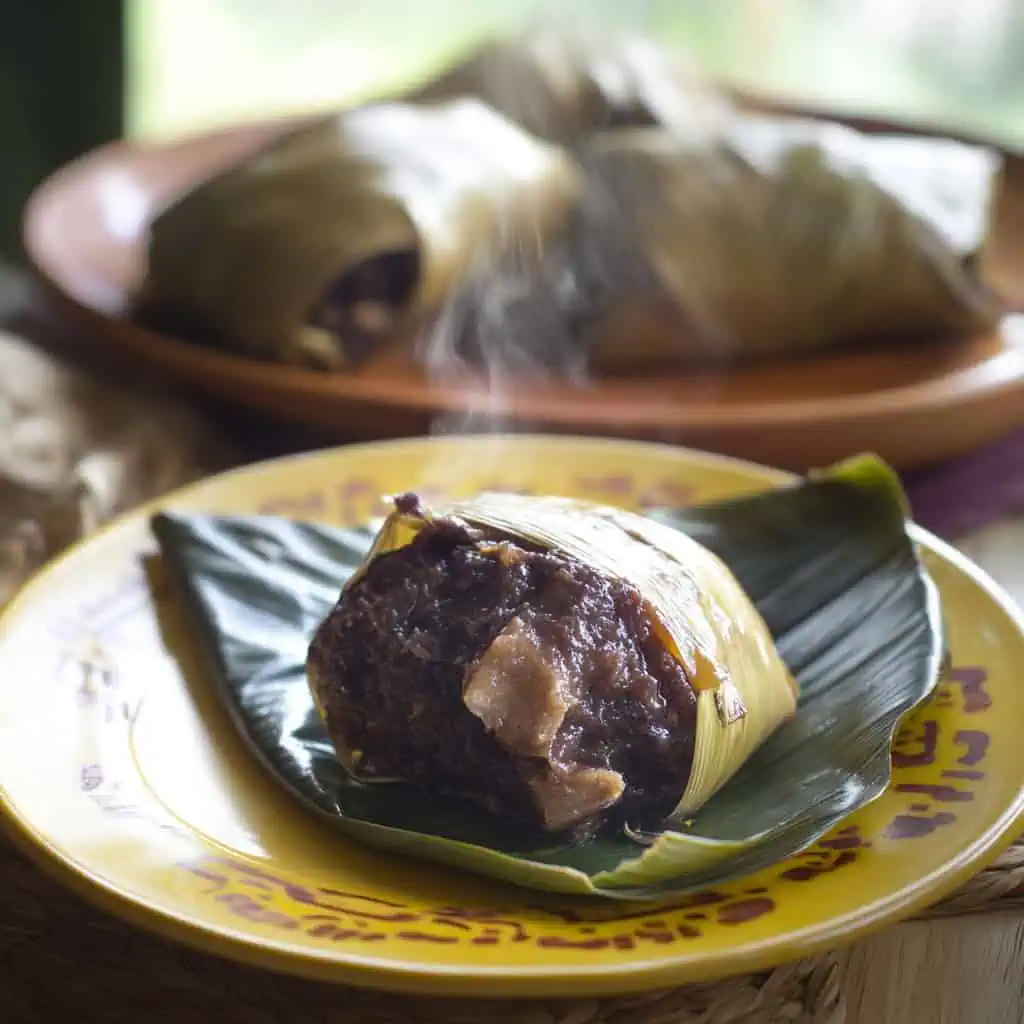
Nutrition
The Story Behind Binagol
Binagol (bee-nah-gol) holds a special place in Filipino culinary heritage as one of the most cherished kakanin (native delicacies) from the Eastern Visayas region. This sweet treat has been prepared for generations by skilled hands in Leyte province, particularly around Tacloban City, where it's become famous as a must-try pasalubong (food souvenir).
The name "Binagol" reveals its traditional preparation method – it comes from the Waray word "bagol," meaning coconut shell. For centuries, local cooks would prepare a mixture of gabi (taro root), gata (coconut cream), and asukal (sugar), then steam it inside coconut shells wrapped in fragrant dahon ng saging (banana leaves). This ingenious cooking method demonstrates how our Filipino ancestors skillfully used natural resources as cooking vessels long before modern kitchenware existed.
What makes Binagol special among Filipino desserts is its unique texture – a perfect balance between creamy and chewy – and the earthy flavor of taro complemented by rich coconut. The banana leaves impart a subtle aroma that enhances the sensory experience. Traditionally, families would gather to prepare Binagol for special occasions like fiestas and holiday celebrations, making it not just a dessert but a symbol of community and hospitality.
When you visit Leyte today, you'll find Binagol vendors at the Tacloban City Market, bus terminals, and even the airport. Many travelers have their favorite vendors, whose recipes have been passed down through generations. Each family recipe carries slight variations in sweetness and texture, but all maintain the core preparation methods that make Binagol authentic.
During typhoon Yolanda (Haiyan) in 2013, many traditional Binagol makers lost their livelihoods. The revival of this beloved delicacy became a symbol of resilience and cultural preservation for the people of Leyte. Today, Binagol continues to be a source of pride and economic opportunity for many small-scale food entrepreneurs in the region.
This adapted recipe honors the traditional methods while making Binagol accessible for home cooks without access to coconut shells. It also offers a vegan version that maintains the authentic flavors while accommodating modern dietary preferences. By preparing this dish in your kitchen, you're connecting with centuries of Filipino culinary tradition and the rich cultural heritage of the Visayas region.
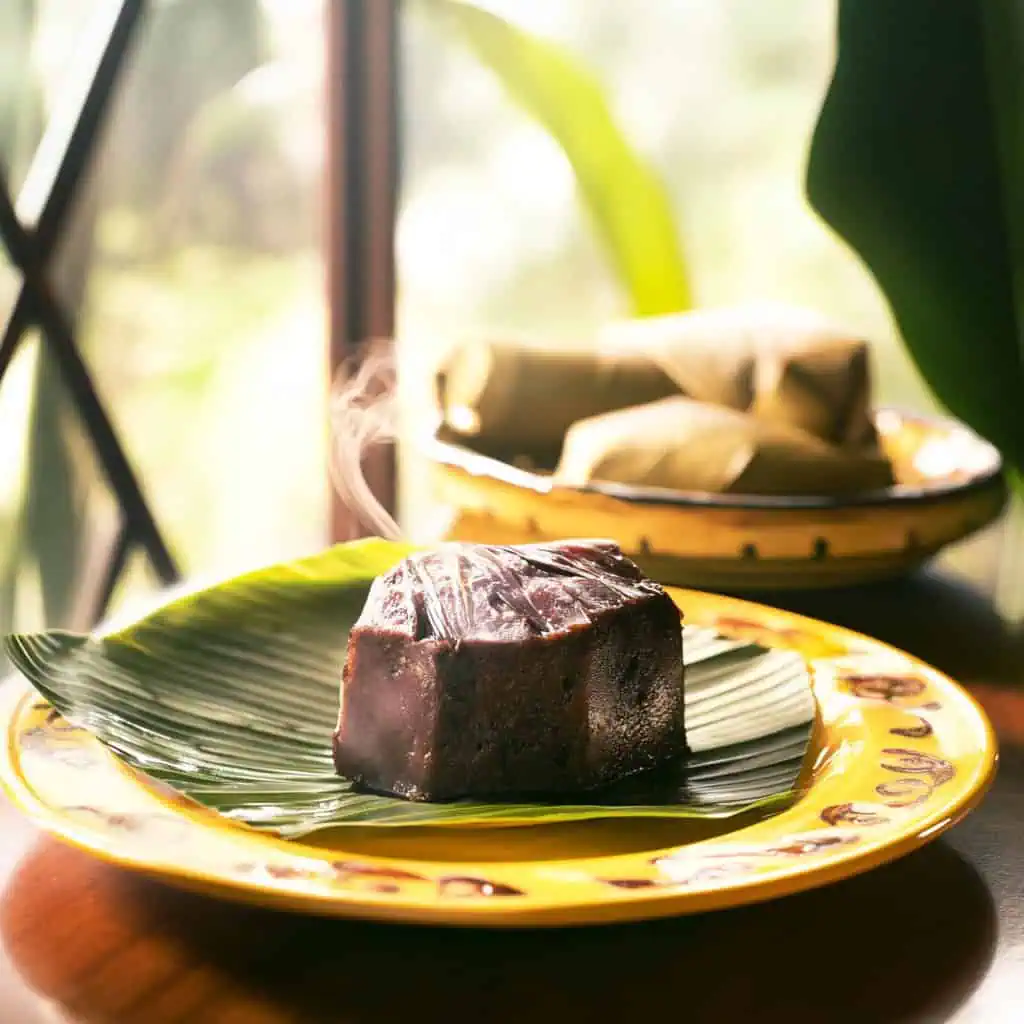

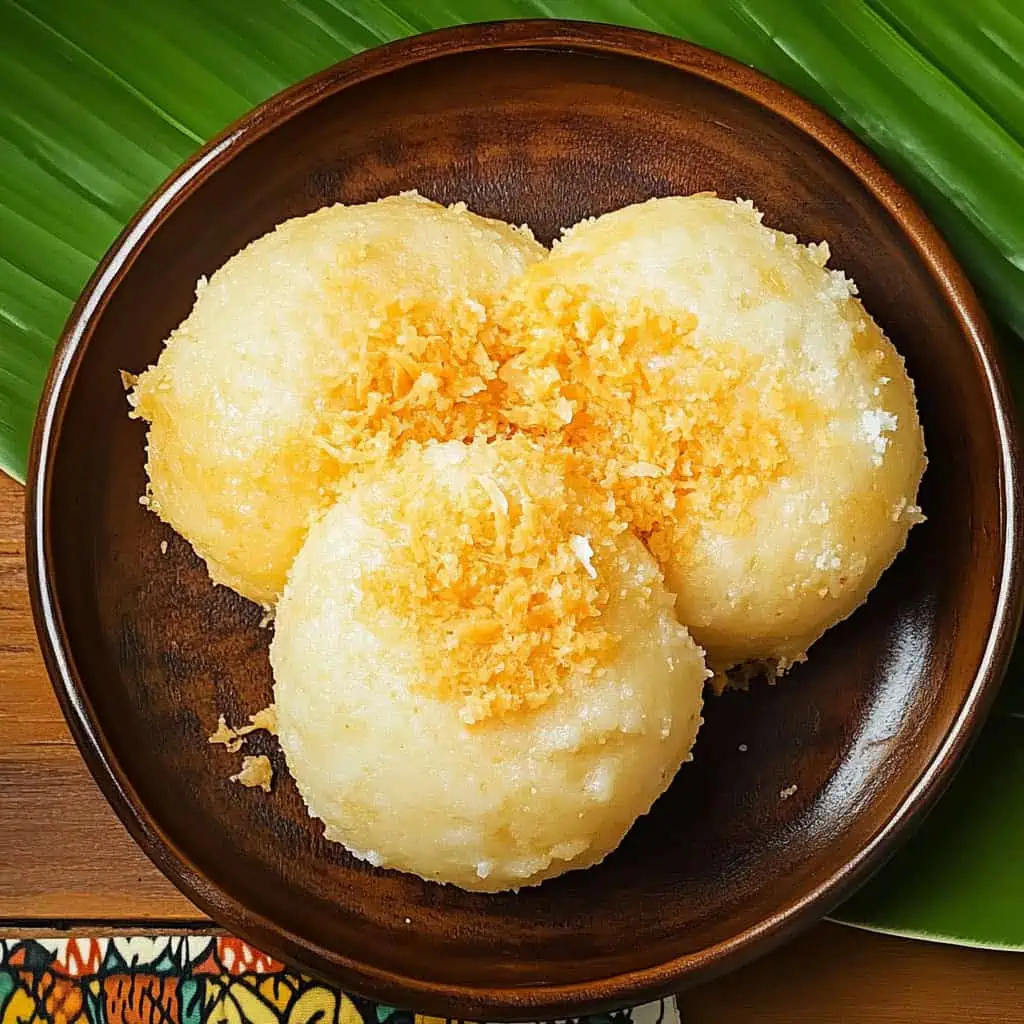
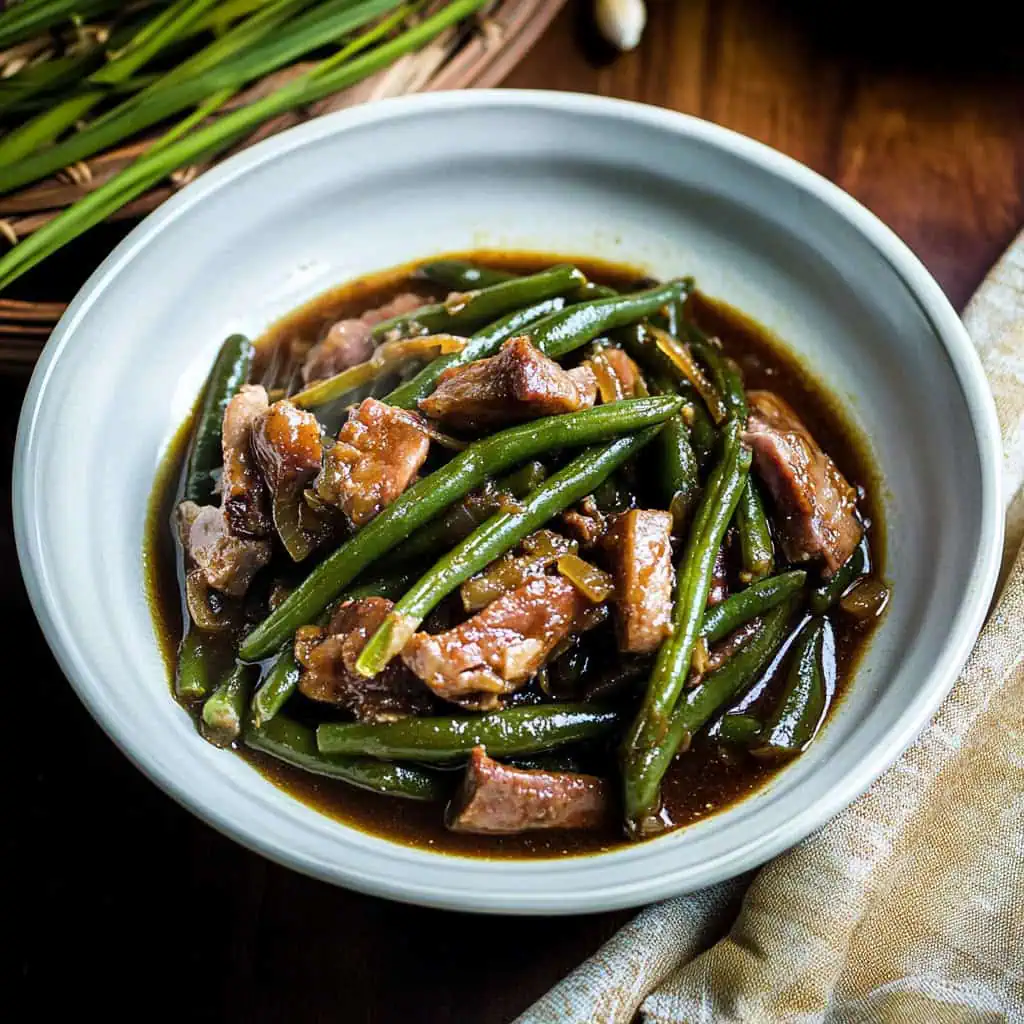

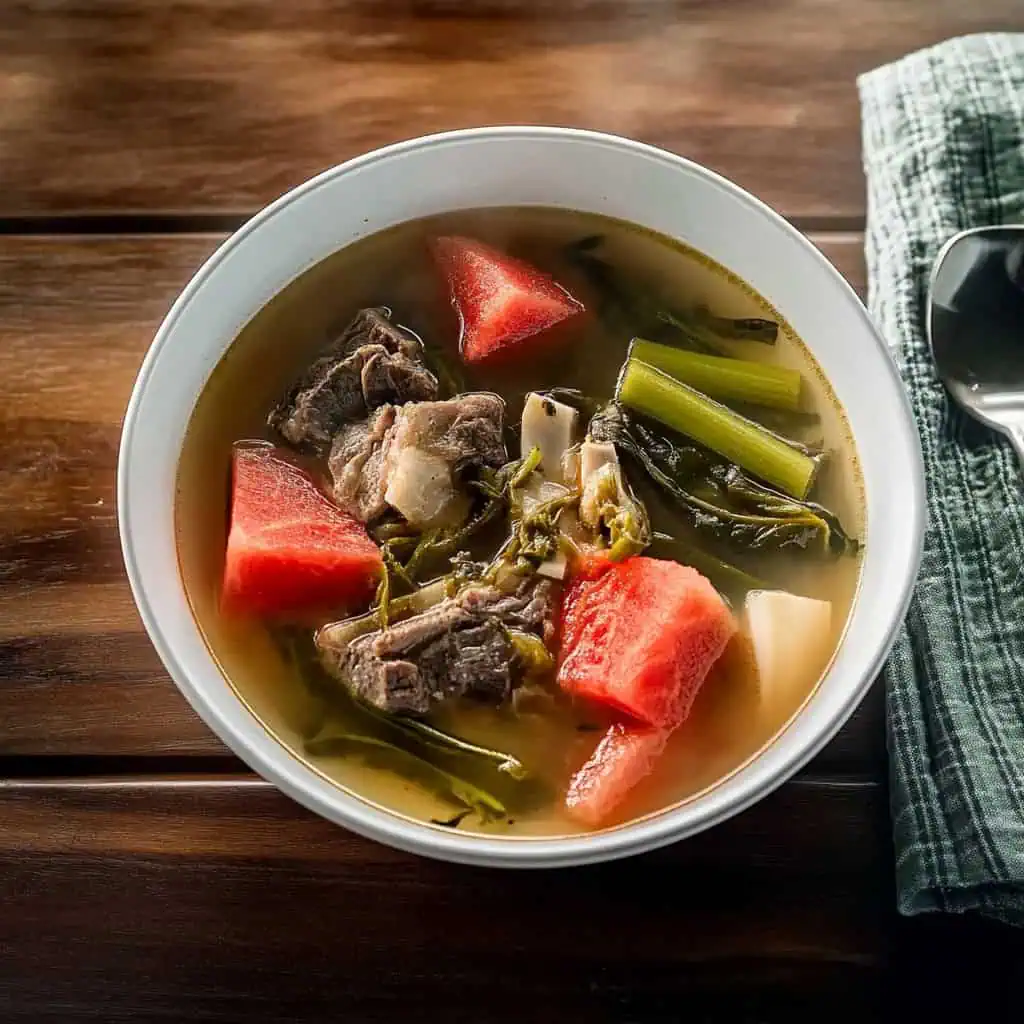


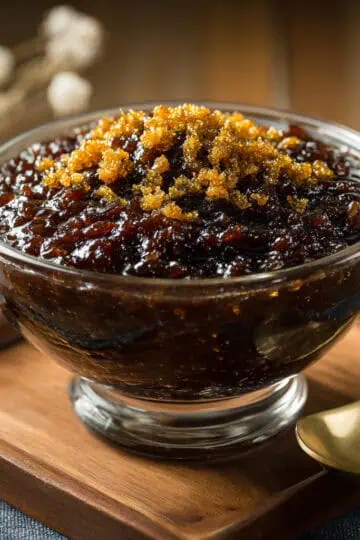
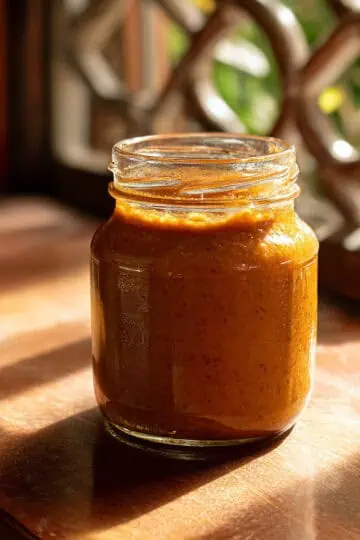
Comments
No Comments